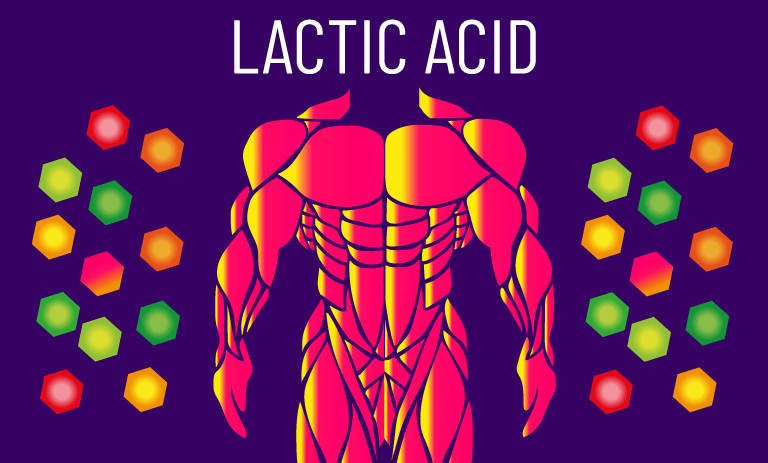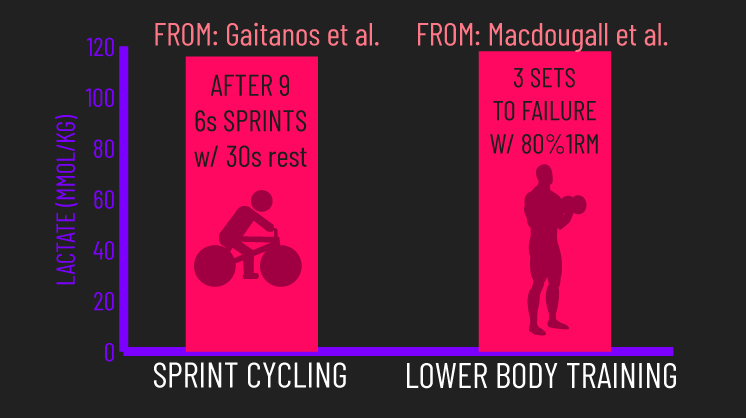
Lactic acid is crucial, essential, mandatory for maxing muscle growth?
The burn is where pain turns into gains.
There’s a decent probability you’ve heard something along these lines.
But what does the scientific literature say on lactic acid (as well as the build-up of other metabolites generally) for muscle growth?
Let’s take a look.
Table of Contents
Part I: “Lactic Acid” Myths
Before anything else, it’s worth debunking common lactic acid mainstream myths.
The first myth is the term “lactic acid”. Under normal human physiological conditions, lactic acid largely does not. Rather, it’s lactate (which is lactic acid minus a hydrogen ion) that’s present in humans.
The second myth is lactate causes fatigue. This idea comes from correlation and hypothetical research conducted before the 1990s.
Since then, a multitude of higher-quality evidence indicates lactate does not cause fatigue nor is it a poisonous substance. In fact, lactate can actually be a fuel source for muscle and brain function and contributes to an array of other positive things.
The third myth is lactate solely produces the pain or burning sensations during intense exercise.
This elegant 2014 paper from the USA shows this isn’t the case.
Experimentally infusing lactate to high levels alone did not induce pain sensations.
Moreover, individually infusing either ATP or hydrogen (two other metabolites) to high levels also did not produce pain sensations.
It was only when all three of the metabolites (so ATP, hydrogen, and lactate) were concurrently infused to high levels did pain sensations occur.
Indicating it’s a combination of metabolites that drives the sensations of pain, individually elevating a single metabolite does not do this.
So humans don’t truly produce lactic acid (rather lactate), lactate does not drive fatigue, and lactate alone does not cause pain sensations during intense exercise.
But does lactate cause hypertrophy?
Part II: More Lactate, More Hypertrophy?
This 2022 review paper from the USA nicely summarizes a multitude of papers finding lactate may play a role in muscle hypertrophy through the activation of satellite cells and the activation of various proteins involved in signaling muscle growth.
Yet, a major consideration is all this research is either in vitro based (i.e done outside the human body) or animal based.
As an example, this study found in rats treadmill running for 4 weeks, consuming lactate and caffeine produced greater muscle hypertrophy versus not consuming these things. Of course, the caffeine consumption does confound things here.
Aside from in vitro and animal papers, lactate increases from exercise are associated with temporary testosterone increases.
Yet, a strong amount of literature indicates temporary increases in anabolic hormones from training (like testosterone) are not associated with muscle growth, it may be more so related to mobilizing fuel for muscle contractions.
In totality, I’m sure many would agree this overviewed evidence isn’t great for inferring lactate is a powerful driver of hypertrophy.
Other higher-quality data questions the importance of lactate for hypertrophy.
Before addressing this, if you’re curious about creating an effective training program for muscle hypertrophy, our high quality partner Alpha Progression can help. It can generate a highly effective program for you, track your workouts live with in-built progression recommendations, provide graphs displaying your long term progress, and it has a massive exercise database with more than 550 exercises.
Click HERE (the link opens in a new tab) to get a free 2 week trial of the apps features. If you like it and go beyond, the link also gives you 20% off a subscription!
We never promote trash at the House of Hypertrophy, so rest assured the app is high quality. The reviews speak to this, 4.8 starts (based on more than 7,000 reviews) on Google play, and 4.9 stars in Apple’s store (based on nearly 400 ratings).
Part III: More Lactate Does Not Mean More Gains?
What if we injected humans with lactate while working out?
If lactate powerfully stimulated hypertrophy, we would expect this to increase the activation of key proteins involved in muscle hypertrophy.
A 2020 Swedish study did this and found that injecting lactate into subject’s arms throughout leg extension training successfully increased blood and muscle lactate levels, but it did not increase activation of key proteins involved in muscle hypertrophy any more than injecting saline (which is just salt and water).
Now, although injecting lactate did increase muscle lactate levels, as just noted, the increases were not massive. It would have been better to directly inject lactate into the leg muscles (as opposed to the arm) to produce larger muscle lactate increases.
Nevertheless, other fascinating data still question lactate’s importance for hypertrophy.
Sprinting for 400 meters seems to produce comparable muscle lactate increases to a lower body training session involving 5 sets of 4 different quad exercises.

Yet we can certainly say lower body training sessions will build muscle more than 400m running.
Repeated short cycling sprints appear to produce comparable muscle lactate elevations to 3 sets of dumbbell curls to failure, and sprint cycling is certainly not going to be the most hypertrophic stimulus in the long run.

Different rep tempos, as indicated by this 2009 Japanese paper, produce different lactate increases even when reps are performed to exhaustion.

But the literature indicates when reps are performed to failure, a wide range of rep tempos are similar for building muscle.
In fact, the Japenese paper indicates a slower lowering tempo produces the lowest lactate increase, yet some research indicates slower lowering tempos could build more muscle (though this isn’t a consistent finding and I plan to cover this more in the future).
Short rests between sets can increase lactate more, but as noted previously at the House of Hypertrophy, longer rests between large muscle mass exercise sets produce more hypertrophy versus shorter rests.
Illustrating this concept, a 2016 English paper found when training the leg press and leg extension with these variables, resting 1 minute between sets produced greater lactate elevations versus 5 minutes between sets, but myofibrillar protein synthesis (i.e. the creation of the proteins that make muscles bigger) was largely greater after resting for 5 minutes between sets.
This 2021 Brazillian study used a novel method that further questions lactate’s hypertrophic value.
Subjects trained the leg extensions with these variables. One condition rested normally between sets. A second condition blood flow restricted their leg with a cuff during the rests between sets which ultimately lead to greater overall lactate elevations versus the first condition.
Yet quadriceps growth ended up being similar between both conditions after 8 weeks of training.
In my view, this overviewed evidence strongly suggests lactate is not a potent driver of hypertrophy.
Finally for this section, it’s worth understanding once lactate is produced by muscle fibers, it doesn’t necessarily stay dormant there. It can be converted to fuel for contraction, shuttled to other muscle fibers of the same or different muscles, and even shuttled to the body’s organs.
These facts may further blunt the idea lactate powerfully drives muscle growth.
Part IV: Other Metabolites?
Lactate is just one metabolite from thousands. Does greater metabolite build up overall lead to more hypertrophy?
As implicated by a 2019 German review paper, higher reps performed to or close to failure (and we can include blood flow restriction training performed with high reps here too) would likely produce greater overall metabolite build-up versus lower reps.
Yet the literature indicates blood flow restriction, higher reps, and lower reps can all be similar for building muscle (one and two).
However, some may think though hypertrophy is similar between these, the growth stimuli differ between them.
Namely, higher reps and blood flow restriction cause muscle growth through metabolite build-up, while lower rep training causes muscle growth through mechanical tension.
But as discussed in a great 2017 review from the USA, this is most likely false.
Mechanical tension seems to be the most powerful driver of muscle hypertrophy, and it’s very likely blood flow restriction, higher reps, and lower reps all cause similar mechanical tension, thus explaining the similar hypertrophy.
You see, mechanical tension is the force experienced by muscle fibers.
Muscle fibers have mechanosensors that can detect the force produced by them, and convert this force into a signaling event that produces muscle hypertrophy. The process of forces being converted into signaling events has the cool name of mechanotransduction.
To maximize overall mechanical tension, we’d want to recruit as many fibers as possible and have the fibers produce good force levels for a decent duration.
Training to or close to failure accomplishes this, regardless of whether blood flow restriction, higher or lower reps are used.
Lower reps with heavier loads will instantly involve high mechanical tension and it only increases as you near failure.
Higher reps and blood flow restriction initially involve low mechanical tension, but as you continue repping out and nearing failure, more muscle fibers are recruited and many fibers may increase their force contribution.
Ultimately, overall mechanical tension ends up being comparable between these things.
As implied in that aforementioned 2017 review, the metabolite build-up with higher reps or blood flow restriction training may be a byproduct of the effort and energy utilization to get to or close to failure, it’s not the cause of muscle growth.
Two other (one and two) fascinating papers demonstrate that metabolite build-up may play a minimal role in hypertrophy.
These two papers had two conditions.
One condition involved subjects training normally with sets of reps to failure.
The second condition also involved subjects training normally with sets of reps to failure, but once completing this the trained limb had a blood flow restriction cuff applied to it for 3-5 minutes. This blood flow restriction would have trapped the metabolites in the muscle (note on screen confirmed in by pilot data, see if both studies confirmed this), and if metabolites could boost muscle growth, this condition should see more muscle growth.
Yet, after 8 weeks, both studies found muscle growth was not enhanced when applying the blood flow restriction after training, one of the papers actually found it reduced muscle growth in the women subjects.
Part V: Summary
Crystalizing this article, humans don’t truly produce lactic acid (rather lactate), lactate does not cause fatigue, and lactate alone doesn’t drive the pain sensations during intense exercise.
Solid literature indicates lactate (as well as metabolite build-up in general) isn’t a powerful driver of hypertrophy. They don’t seem to confer additional gains beyond what’s provoked by mechanical tension.
I don’t want to make the mistake of saying just because more of something (i.e. metabolites) does not mean more hypertrophy, it means metabolites play a 0% role in muscle growth.
It’s possible there’s a threshold beyond which metabolites provide no further hypertrophy. The threshold may be very low and much of the research overviewed passed that threshold, explaining why infusing lactate during training, higher reps, blood flow restriction, or trapping metabolites via blood flow restriction provided no added hypertrophy.
Alternatively, perhaps metabolites are anabolic at extreme levels, levels not feasible or possible in humans. Matter of fact, much of the in vitro research linking lactate to muscle hypertrophy involved continuous high lactate exposure for 2-6 hours, with some even lasting for days.
More research is required to pinpoint if either speculation holds any truth, or if metabolites are completely irrelevant for hypertrophy.
What is clear is that mechanical tension should be your primary focus if the goal is to build muscle, and this is simply done by just ensuring your performing your reps to or close to failure.


Excellent info. In light of this article below by Beardsley, how does one justify higher rep ranges at all for purposes of hypertrophy? If type 2 fibers are not recruited until the final 5 reps of any given set taken to failure, per Beardsley, I can’t think of a reason to perform longer sets for purposes of hypertrophy. Can you address my questions? Thanks.
Here’s the article by Beardsley.
https://sandcresearch.medium.com/what-is-training-volume-286b8da6f427